Science globetrotters
This is a story without a single narrative — but rather tales of people who have maintained simultaneous scientific endeavors in two parts of the world, with one base in the U.S. Their motivations for doing so are all over the map.
Helping the home country:
Carlos Bustamante, University of California, Berkeley
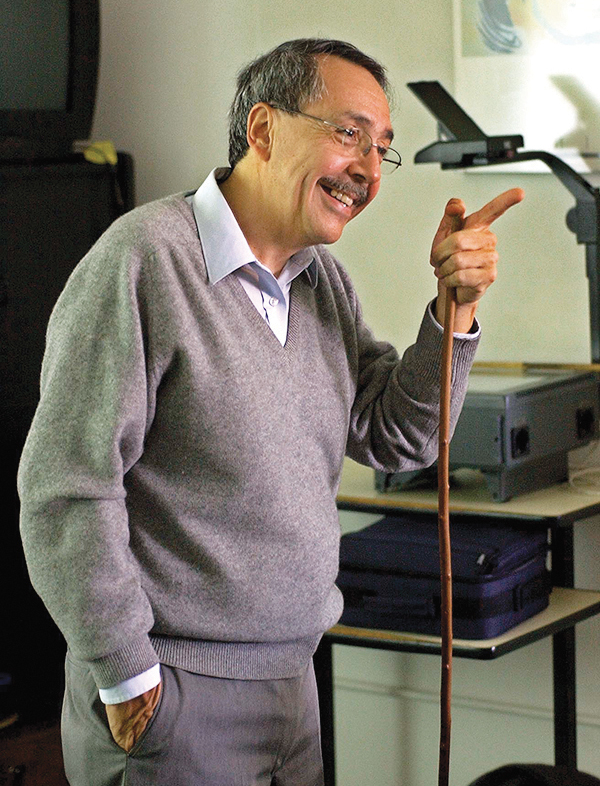 “Twin labs” is what Carlos Bustamante calls his setup. An expert in single-molecule manipulation techniques, Bustamante runs laboratories both at the University of California, Berkeley, and Cayetano Heredia University in Lima, Peru.
“Twin labs” is what Carlos Bustamante calls his setup. An expert in single-molecule manipulation techniques, Bustamante runs laboratories both at the University of California, Berkeley, and Cayetano Heredia University in Lima, Peru.In the 1980s, Bustamante intended to return to his home country of Peru after completing his Ph.D. at Berkeley. “But by the time I was finishing my Ph.D., it was impossible to go back,” he says. “The country was in the midst of a revolution by the terrorist Maoist group called Shining Path.”
Bustamante built his career in the U.S. developing optical and magnetic tweezers that researchers use to manipulate individual molecules, such as DNA and DNA polymerase, and to get a close-up view of molecular dynamics.
In 2005, officials at Cayetano Heredia University asked him to help invite American scientists to give lectures to students at the university. With the lecture series for three years, “I realized that even though I was not going to go back to Peru as a scientist, I still could do something to help my country to strengthen its science and technology,” says Bustamante. “Eventually the idea came up of creating a twin laboratory in Lima that would be parallel to mine.”
Bustamante corralled representatives of the major universities in Peru and made his pitch for mirror labs. The next day, officials at Cayetano Heredia University offered to host the laboratory. Bustamante explained the idea to officials at Berkeley and got their support.
The laboratory in Lima got off the ground in 2009 and today has six undergraduate and master’s students. The students get to spend a summer in the Berkeley laboratory, and the flow of people goes the other way as well. “I think the experience of American students going to South America and having the sense of what it is like to live in a country not as rich as this one is a very sobering experience,” notes Bustamante.
The experience is not just for students. Bustamante acknowledges that as an investigator of the Howard Hughes Medical Institute, “I’m not only doing well but I’m doing better than well in some respects. From that point of view, [the Lima laboratory] is very important, because it gives me a perspective and a context that is always good to keep in mind.”
The Lima laboratory, like the Berkeley laboratory, does both fundamental and applied research, but with a local twist. “At my lab at Berkeley, we study transcription by RNA polymerase from yeast or E. coli,” explains Bustamante. “In Peru, we are purifying and isolating the RNA polymerase from Mycobacterium tuberculosis, because tuberculosis continues to be the main cause of death in Peru. The RNA polymerase from mycobacterium is the main drug target for most of the frontline antibiotics that are used today.”
The laboratories stay connected by Skype, but Bustamante goes to Lima three times a year. Bustamante says his family in Peru has been enthusiastic about the project because “for them, it was a good pretext to see me more often instead of once every two years!”
One concern in doing science in developing countries is lack of easy access to reagents and instrument parts. Bustamante has outfitted the Lima laboratory with mostly older instruments from his Berkeley laboratory. “Instead of sending instruments to landfills, we fix them a little bit or the university in Peru pays for fixing them,” says Bustamante. On every trip, Bustamante and his students carry instrument parts and reagents in their luggage to bypass delays they would otherwise hit with mail-order service. “We want to avoid the kind of delays this sort of collaboration normally involves,” says Bustamante.
The Lima laboratory has had a ripple effect not just within the university where it’s located but also in South America in general, says Bustamante. It’s the only one in the region with an optical tweezers setup, so scientists from Chile and Argentina have requested collaborations because they want access to the instrument. “It’s like a snowball rolling down a hill,” says Bustamante. “The only concern that I have is that I don’t want to be the only Peruvian scientist who does this. There are many Peruvian scientists in the U.S. I think if each one of them tried something like this, we could in a few years completely change the face of the science in Peru.”
Taking the long view:
Chuan He, University of Chicago
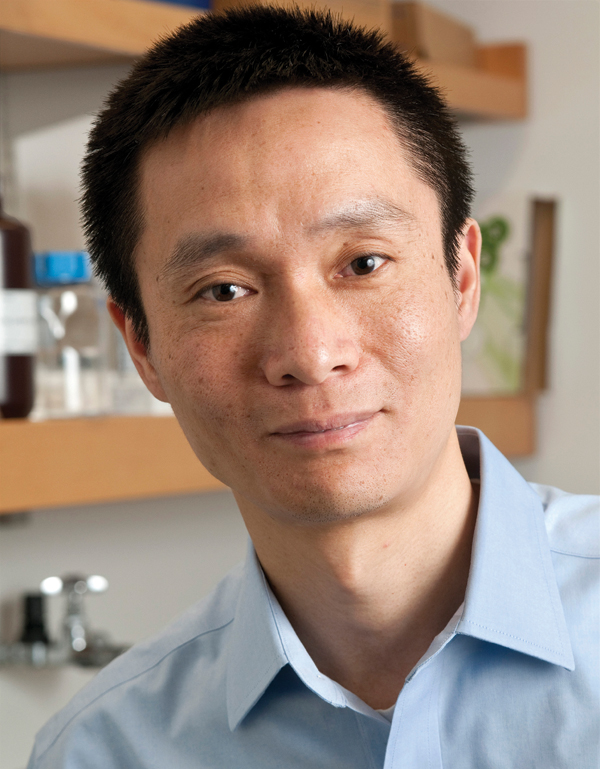 In the late 2000s, Chuan He at the University of Chicago attracted the attention of officials at Peking University in China. His group was busy developing, among other things, chemical methods to study the epigenetic marker 5-hydroxymethylcytosine, which they recently had discovered along with potential RNA demethylation. The Chinese university officials had noted He’s scientific contributions and asked if he’d be willing to help establish a chemical biology center at the university.
In the late 2000s, Chuan He at the University of Chicago attracted the attention of officials at Peking University in China. His group was busy developing, among other things, chemical methods to study the epigenetic marker 5-hydroxymethylcytosine, which they recently had discovered along with potential RNA demethylation. The Chinese university officials had noted He’s scientific contributions and asked if he’d be willing to help establish a chemical biology center at the university.He was impressed by the fact that the Peking University officials were taking the long-term view. In his mind, the center would be defined by faculty members who would start their careers there and eventually become established and successful. “That was going to take 10 to 20 years,” he explains. “It couldn’t be done in three to five years. It would not be sustainable. They completely understood that.”
He accepted Peking University’s offer, and in the summer of 2011 the Synthetic and Functional Biomolecules Centre opened its doors. He found the provost and dean at the University of Chicago very supportive. “I think the university views this as a positive way of building more connections in China,” he notes. The center will have five full-time tenure-track faculty members by the end of 2013, and there are already two assistant professors, who were recruited from the U.S.
He travels to China four or five times a year, making sure his trips to the center coincide with scientific conferences in the region. But He is honest when he says that the timing for this endeavor was not the best. “It happened right when I was transitioning to full professor and my science was beginning to take off,” he says. “It’s a lot of traveling. Occasionally, my family will go with me to China, but with the kids in school, it’s not going to happen regularly.” He has two children, ages 6 and 11.
Still, He says he couldn’t have let the opportunity go. “How many times in a life do you get to build something new?” he asks. “My own science will probably not generate as much impact as this center will in the long run.”
Foreseeing a scientific challenge: Akhilesh Pandey, Johns Hopkins University
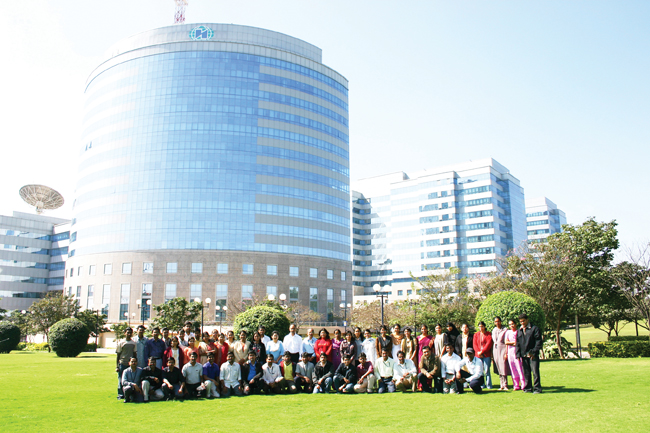 A decade ago, Akhilesh Pandey, then a visiting scientist at the University of Southern Denmark, could see that the demand for bioinformatics was only going to increase. When Pandey landed a tenure-track position at Johns Hopkins University in 2002, he decided to devote his spare time to a bioinformatics institute. “My parents are based in Bangalore. I convinced them to start helping me finance the institute,” he explains. With his parents’ financial backing and credit-card loans, Pandey established the nonprofit Institute for Bioinformatics in India. His parents are on the board of trustees, while Pandey focuses on the science.
A decade ago, Akhilesh Pandey, then a visiting scientist at the University of Southern Denmark, could see that the demand for bioinformatics was only going to increase. When Pandey landed a tenure-track position at Johns Hopkins University in 2002, he decided to devote his spare time to a bioinformatics institute. “My parents are based in Bangalore. I convinced them to start helping me finance the institute,” he explains. With his parents’ financial backing and credit-card loans, Pandey established the nonprofit Institute for Bioinformatics in India. His parents are on the board of trustees, while Pandey focuses on the science.The Institute of Bioinformatics now has 56 employees, and more than 200 students have gone through its doors. It focuses on areas such as database development, computational genomics and proteomics. One of its goals is to create a freely available Human Protein Reference Database using open-source technology and to verify predicted human genes using molecular biology and proteomics-based methods.
Pandey, who visits the institute four or five times a year, acknowledges that funding has been an issue. “We’ve passionately been doing science and largely ignored the funding. Funding has always been a sore point, but somehow we have worked within huge constraints,” he says. “We operate on a shoestring budget.” He has applied for grants in India and is hopeful, because India has significantly increased its spending on biomedical and biotechnological research in the past two years.
Although he describes the institute as a grassroots effort, Pandey has a fierce vision and ambition for it. “The kinds of models I’ve set up for myself are places like the Broad Institute and [the European Molecular Biology Laboratory],” he says. “We have high aspirations.”
Making a transition:
Ruedi Aebersold, ETH Zurich
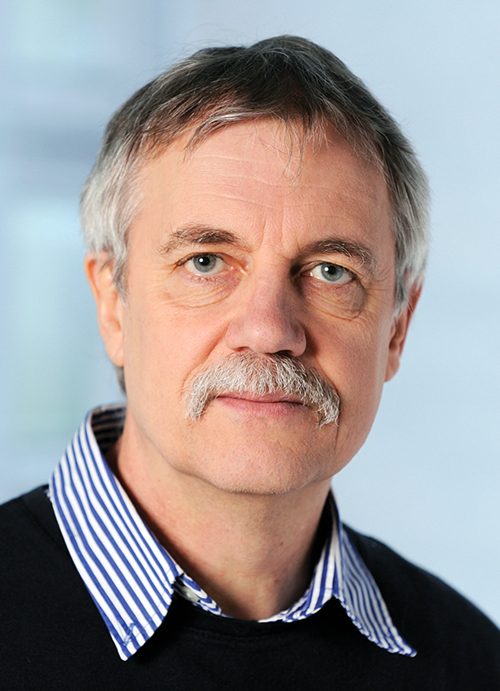 Ruedi Aebersold agreed to run two laboratories in two different countries only because he knew the situation was temporary. In the early 2000s, Aebersold was busy with the Institute for Systems Biology, which he had cofounded with Leroy Hood and Alan Aderem in Seattle. But ETH Zurich, the Swiss university for technology and natural sciences, approached Aebersold with an offer that was impossible to refuse.
Ruedi Aebersold agreed to run two laboratories in two different countries only because he knew the situation was temporary. In the early 2000s, Aebersold was busy with the Institute for Systems Biology, which he had cofounded with Leroy Hood and Alan Aderem in Seattle. But ETH Zurich, the Swiss university for technology and natural sciences, approached Aebersold with an offer that was impossible to refuse.At the time, Aebersold was three years into spearheading a large proteome center at ISB sponsored for seven years by the National Heart, Lung and Blood Institute. When the offer from ETH Zurich came down, Aebersold approached the NHLBI leadership to discuss his options. “They were extremely generous and accommodating,” he says. “They said I could continue to run it, provided I spent 20 percent of my time on the center.”
Running laboratories in Seattle and Zurich “wasn’t something I was aspiring to, nor was it an easy thing to do,” he says.
Firstly, logistics were difficult. Zurich and Seattle have a nine-hour time difference. “It took me a while to figure out how to do this best, because the worst was the one-week visit. You constantly are jetlagged and tired, and then you get back and it goes the other way around,” he says. Aebersold eventually decided that fewer, but longer, visits to Seattle were better, and he used Skype and phone calls to fill in for the other times.
Then there was the human challenge. At the beginning, Aebersold knew everyone well. “It felt as if I was away on a trip,” he says. But over time it grew more difficult because there was turnover. As someone who thinks the small, personal touches are important in a team setting, Aebersold found the loss of face-to-face interaction difficult.
Aebersold’s advice to anyone contemplating a dual-lab arrangement is to think about it carefully. “Is it an opportunity like I was offered that will lead to this long-term, relatively protracted transition? Or is it a permanent solution to some problem?” he asks. “Just doing it because someone offers lab space and instrumentation or some other form of support — I would carefully think if it’s worthwhile.”
An opportunity comes along:
Patrick Casey, Duke University
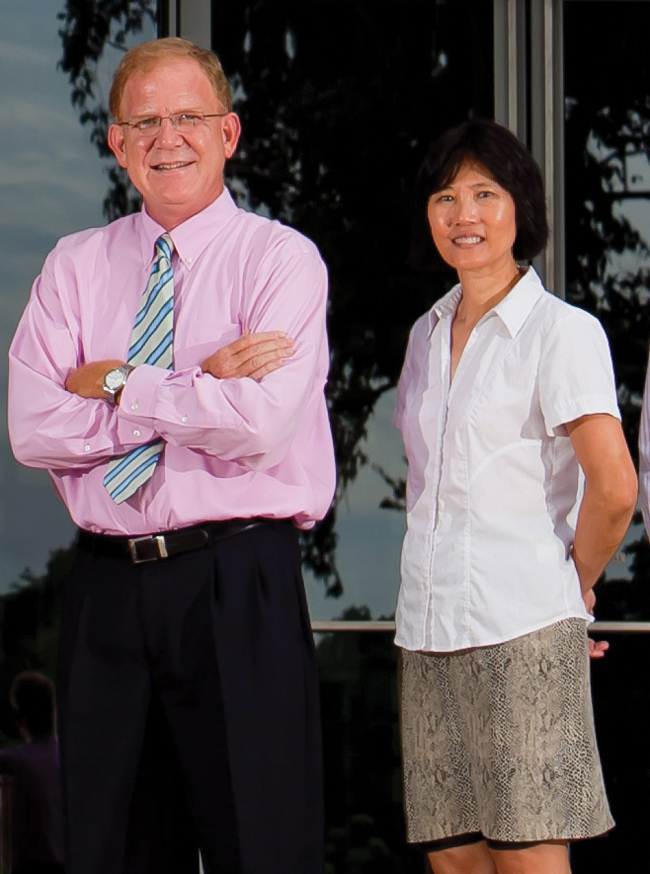 |
| Patrick Casey and Mei Wang |
For Patrick Casey at Duke University, the idea of moving to Singapore gradually crept up. In the early 2000s, the Singaporean government was looking to establish a new medical school and got into talks with Duke University administrators about a possible partnership. Casey got involved because he was building up interdisciplinary sciences at Duke, particularly around translational medicine. “By the spring of 2005, it all came together,” he recalls. “That’s when Duke asked me if I could go over to help get the school off the ground.”
Casey was searching to do something new, and the idea of building a medical school and research institute from the ground up was appealing. “My wife is a clinician-scientist, and she was also looking for an opportunity,” says Casey. From a personal standpoint, a stint in Asia made sense. Casey’s wife, Mei Wang, is Chinese by birth, and her parents would be able to join them in Singapore and spend time with their grandchildren.
Casey and Wang considered the Singapore stint to be temporary, so Casey kept his research group going in North Carolina. “I would spend 10 weeks in Singapore and two weeks in Duke,” explains Casey, describing the two weeks in North Carolina as intense. But Casey did not take on new graduate students and postdoctoral fellows at his Duke laboratory after his move, which “in hindsight, was the right thing to do,” he notes.
As the years went on, each of Casey’s graduate students and postdoctoral fellows completed their training. Their projects either went with them to their next stints or got moved to Singapore, where now both Wang and Casey have their own research groups. When he went back to Duke this summer, Casey turned his laboratory over to another faculty member. He is still active in Duke’s administration but has decided to focus his research efforts in Singapore — knowing that he can always move back to the U.S. if he so desires — because he finds the science happening in Asia to be very exciting.
Casey gives an example: In conversation with a hematologist, one of his NUS-Duke colleagues, Tiong Ong, found out that there was a higher incidence of Asian patients who didn’t respond to the cancer drug imatinib (also known as Gleevec; read the August 2013 issue of ASBMB Today to learn more about it). Hematologists in other Asian countries confirmed the observation. From a genomic-profiling study, Ong’s group discovered “there is a gene variant that is only found in east Asians, in about 15 percent of the population, that not only explains their resistance to imatinib but provides a new target for therapeutics for this population.”
So, much like real estate, science benefits from location. “Patient populations and demographics of disease can really inform a research program,” says Casey. “I had not thought of that much when I was in Duke.”
Timing is everything:
Joan Valentine, University of California, Los Angeles
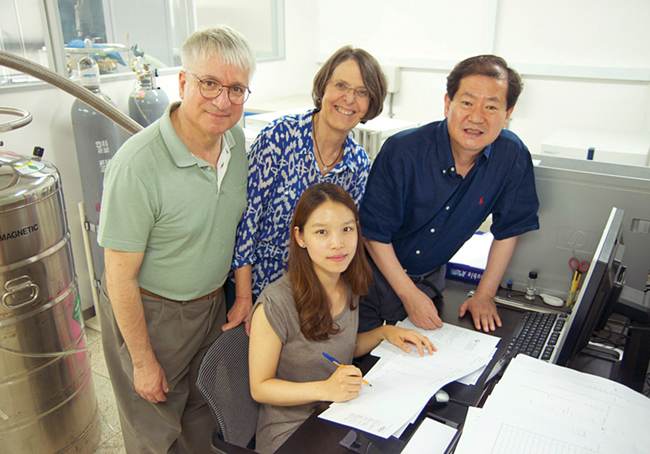 |
| Andrew Clark (Valentine's husband), Joan Valentine, Wonwoo Nam (standing, left to right) and Sumin Lee (seated), who is entering UC Berkeley as a Ph.D. candidate in the chemistry department this fall. Photographer: Atsutoshi Yokoyama |
A former graduate student of Joan Valentine’s recruited her to the Ewha Womans University in South Korea. Wonwoo Nam had established himself as a chemistry professor at the university, one of South Korea’s top institutions with an all-female student body. In the mid-2000s, Valentine, who is at the University of California, Los Angeles, got a call from Nam. He described a new initiative to be launched by the South Korean government called World Class University, in which researchers in science, technology, engineering, math and social science fields from around the world would be invited to spend part of every year at a South Korean institution and get funding to do research and teaching. On hearing the proposal, Valentine recalls telling Nam that “there was no way” UCLA would let her do that. “But Wonwoo, who is my dear friend, is very persistent.”
Nam and Valentine spoke with the dean of physical sciences at UCLA, proposing the idea that her research would benefit from spending time abroad. The dean happened to be a physicist. “Physicists have to go to labs all over the place all the time because of specialized facilities,” says Valentine. “The idea that I would be able to extend my research efforts and get more resources that would be published under UCLA as well as Ewha — that was normal to a physicist.”
Since 2009, Valentine and her husband, who is an independent scholar of ancient Greek vases, have been going to South Korea every year for four months. “I’m sure I couldn’t have done it if my husband had to stay behind,” she says.
Valentine collaborates with Nam, who works on biomimetic and inorganic chemistry; Valentine’s UCLA laboratory focuses on superoxide dismutase and its role in amyotrophic lateral sclerosis. The collaboration has been wonderful, says Valentine, because she gets to revisit an area of research she had to abandon. “I’m at a later stage in my career,” she says. “Right from the beginning, I told Wonwoo that I didn’t want another independent research lab.”
The World Class University attracts scientists from all over, and Valentine has found the experience to be enriching. “I feel as though as I’ve had an opportunity to start talking science with people in a way that I haven’t done since I was an assistant professor,” she says.
Valentine also teaches master’s students metal and oxygen chemistry and plays the role of cultural ambassador. The top students get their master’s degrees at Ewha and head off to the U.S. to get their Ph.D.s. “These are wonderful, brilliant young women, but I’ve been talking to them about the requirement to be more assertive right from the beginning. They don’t even want to make eye contact,” says Valentine. “I’ve really challenged them with that. I’ve said to them, ‘You’ve got to be willing to make eye contact!’”
When Valentine is back in the U.S., she stays in regular contact with Nam. But she doesn’t directly interact with the Korean students, because “although they speak English, they are very shy to do so. It’s a lot of effort for them to converse in English over Skype.” While in South Korea, Valentine keeps up with her UCLA group by Skype and email.
To anyone considering a similar move, Valentine offers this advice: “If you’re feeling a little restless in what you’re doing now and this opportunity comes along, you should certainly explore it. If you’re totally satisfied and busy with what you’re doing, it’s probably not for you, because it takes too much of your attention away from your primary goal.” And then Valentine offers a practical tip: “You should like the food of the place you’re going. Korean food is great!”
Enjoy reading ASBMB Today?
Become a member to receive the print edition four times a year and the digital edition monthly.
Learn moreFeatured jobs
from the ASBMB career center
Get the latest from ASBMB Today
Enter your email address, and we’ll send you a weekly email with recent articles, interviews and more.
Latest in People
People highlights or most popular articles

Nuñez receives Vallee Scholar Award
He will receive $400,000 to support his research.

Mydy named Purdue assistant professor
Her lab will focus on protein structure and function, enzyme mechanisms and plant natural product biosynthesis, working to characterize and engineer plant natural products for therapeutic and agricultural applications.

In memoriam: Michael J. Chamberlin
He discovered RNA polymerase and was an ASBMB member for nearly 60 years.

Building the blueprint to block HIV
Wesley Sundquist will present his work on the HIV capsid and revolutionary drug, Lenacapavir, at the ASBMB Annual Meeting, March 7–10, in Maryland.

In memoriam: Alan G. Goodridge
He made pioneering discoveries on lipid metabolism and was an ASBMB member since 1971.

Alrubaye wins research and teaching awards
He was honored at the NACTA 2025 conference for the Educator Award and at the U of A State and National Awards reception for the Faculty Gold Medal.

